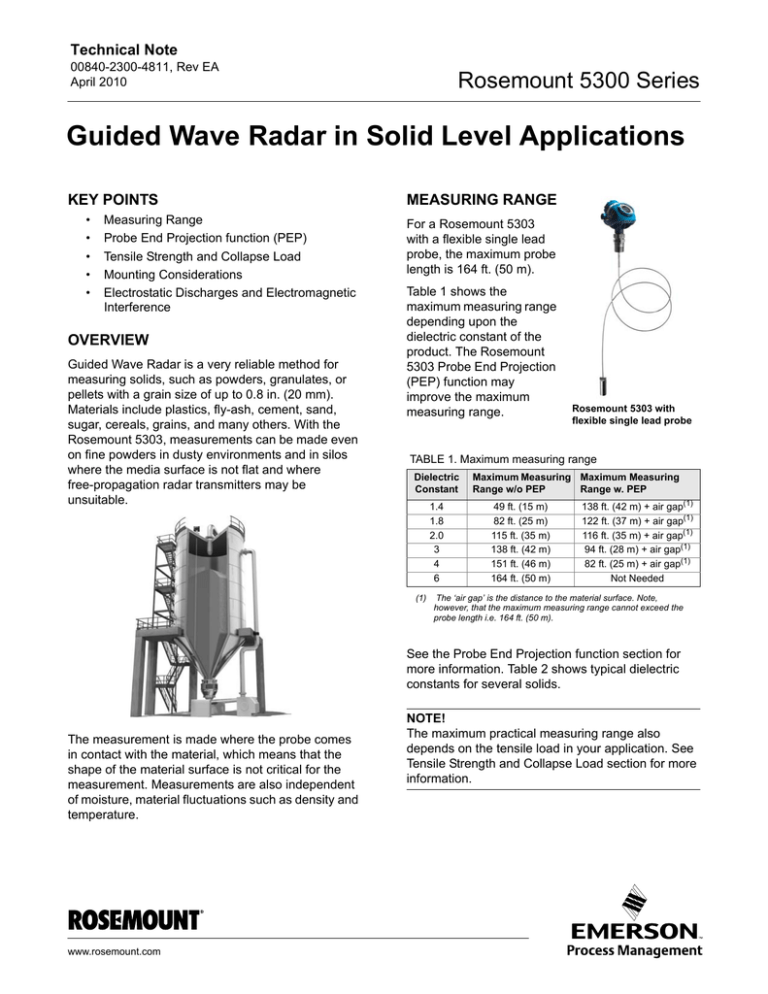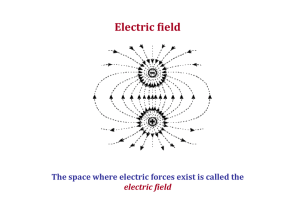
Technical Note
00840-2300-4811, Rev EA
April 2010
Rosemount 5300 Series
Guided Wave Radar in Solid Level Applications
KEY POINTS
•
•
•
•
•
Measuring Range
Probe End Projection function (PEP)
Tensile Strength and Collapse Load
Mounting Considerations
Electrostatic Discharges and Electromagnetic
Interference
OVERVIEW
Guided Wave Radar is a very reliable method for
measuring solids, such as powders, granulates, or
pellets with a grain size of up to 0.8 in. (20 mm).
Materials include plastics, fly-ash, cement, sand,
sugar, cereals, grains, and many others. With the
Rosemount 5303, measurements can be made even
on fine powders in dusty environments and in silos
where the media surface is not flat and where
free-propagation radar transmitters may be
unsuitable.
MEASURING RANGE
For a Rosemount 5303
with a flexible single lead
probe, the maximum probe
length is 164 ft. (50 m).
Table 1 shows the
maximum measuring range
depending upon the
dielectric constant of the
product. The Rosemount
5303 Probe End Projection
(PEP) function may
improve the maximum
measuring range.
Rosemount 5303 with
flexible single lead probe
TABLE 1. Maximum measuring range
Dielectric
Constant
1.4
1.8
2.0
3
4
6
(1)
Maximum Measuring Maximum Measuring
Range w/o PEP
Range w. PEP
49 ft. (15 m)
82 ft. (25 m)
115 ft. (35 m)
138 ft. (42 m)
151 ft. (46 m)
164 ft. (50 m)
138 ft. (42 m) + air gap(1)
122 ft. (37 m) + air gap(1)
116 ft. (35 m) + air gap(1)
94 ft. (28 m) + air gap(1)
82 ft. (25 m) + air gap(1)
Not Needed
The ‘air gap’ is the distance to the material surface. Note,
however, that the maximum measuring range cannot exceed the
probe length i.e. 164 ft. (50 m).
See the Probe End Projection function section for
more information. Table 2 shows typical dielectric
constants for several solids.
The measurement is made where the probe comes
in contact with the material, which means that the
shape of the material surface is not critical for the
measurement. Measurements are also independent
of moisture, material fluctuations such as density and
temperature.
www.rosemount.com
NOTE!
The maximum practical measuring range also
depends on the tensile load in your application. See
Tensile Strength and Collapse Load section for more
information.
Technical Note
Rosemount 5300 Series
TABLE 2. Dielectric Constants of Typical Bulk Solids
Dielectric
Constants(1) Typical Bulk Solids
Rosemount 5303
Maximum
Measuring Range
1.1 - 1.9
See Table 1
1.9 - 2.5
2.5 - 4.0
4.0 - 7.0
> 7.0
(1)
• Plastic powder, granulate
• White lime, special cement
• Dry sawdust
• Sugar granulate
• Cement, plain
• Fly ash
• Burnt Lime
• Coal dust, dry
• Portland cement
• Plaster
• Starch
• Grain, seeds
• Ground stones
• Carbon black
• Sand
• Naturally moist (ground)
• Stones, ores
• Salt
• Cement powder
• Carbon black
• Coal dust, moist
• Brown coal
• Metallic powders
• Calcium Carbonate
See Table 1
See Table 1
See Table 1
PROBE END PROJECTION FUNCTION
Probe End Projection (PEP) is a function in the 5303
transmitter that allows for measurements when the
surface pulse is too weak to be detected. This
commonly occurs when the material dielectric is very
low, especially in combination with a long distance to
the surface, or electromagnetic interference. The
method is based on the fact that microwaves
propagate slower through product than through air.
By using the product dielectric constant and the
probe end echo, the surface position is calculated
when the surface echo is unavailable. The PEP
function will only be activated as a backup if the
surface echo is too weak.
Reference pulse
164 ft. (50 m)
No pulse from
the surface
Dielectric values can differ depending on particle size
and the amount of air or moisture in the material. More
air will lower the dielectric value while more moisture will
increase it. These tables provide a rough guideline.
NOTE!
For dielectric constants <1.4, the surface pulse may
be too weak to be detected and measurements
cannot be made unless the Probe End Projection
function is used.
NOTE!
For longer measuring ranges, non-contacting radar
may be a better choice. See Technical Note
Measuring Solids with a Rosemount 5600
Non-Contacting Radar (Document Number
00840-0100-4024).
2
00840-2300-4811, Rev EA
April 2010
Probe end pulse
The PEP function is recommended for solids with a
dielectric constant less than or equal to 2. The
maximum measuring range with PEP is 164 ft. (50 m)
(maximum probe length) divided by the square root
(sqrt) of the material dielectric constant (DC) + the air
gap to the material surface.
If the DC is 2 and the vessel is filled, the maximum
measuring range is 115 ft. (35 m) (e.g. 164 ft. (50 m) /
sqrt(2)). For a lower DC or with an air gap in the top
of a vessel, it is possible to measure longer distances
(see Table 1 on page 1 for details).
Technical Note
00840-2300-4811, Rev EA
April 2010
Rosemount 5300 Series
Measurement Output
Surface Threshold
Surface Pulse
Over threshold
meaning directly
measured
Probe End Pulse
Would be positive
if anchored
Reference Pulse
(a) Echo Curve Showing Surface Directly Measured
Measurement Output
PEP calculates the surface by using probe
end and product dielectric constant
Surface Threshold
Surface Pulse
Too Weak To
Be Detected
Reference Pulse
Probe End Pulse
Would be positive
if anchored
(b) Echo Curve Showing Surface Detected By PEP
3
Technical Note
Rosemount 5300 Series
00840-2300-4811, Rev EA
April 2010
The PEP is easily configured by using the guided
setup in either Rosemount Radar Master, AMS®, or
the Field communicator. For best performance,
complete the guided setup with an empty vessel to
accurately calibrate probe end offset and probe end
pulse polarity, and then a second time with material
in the vessel to get a surface echo to calculate the
product dielectric constant.
For detailed information on configuring PEP, see the
Rosemount 5300 Series Reference Manual
(Document Number 00809-0100-4530)
NOTE!
Accuracy is highly dependent on a correctly
configured DC value, and may be affected when
using PEP. The longer the measuring range, the
higher the error (e.g. sqrt(DC error)*measure range).
It is therefore recommended to only use PEP when
required and allow the transmitter to go into direct
measuring mode. Obtaining the real surface echo will
allow automatic correction of the DC. Do not set the
surface echo threshold too high in areas where it is
possible to reliably detect the real surface. Instead,
allow the surface to sometimes be within the
maximum measuring range without PEP
(see Table 1). However, even if the accuracy may be
affected, the repeatability will not be affected.
NOTE!
If PEP is used to measure in an application with EMI,
the accuracy may be affected. For example, if the
surface echo is too weak to distinguish from the
noise and the surface threshold is raised to only use
the probe end pulse, accuracy will be affected if the
DC is not configured correctly.
4
NOTE!
Fixing the end of the probe to a surface (e.g. silo
wall) affects the PEP accuracy. First, due to the slack
of the probe needed to reduce the risk of probe
breakage, the measurement is slightly non-linear.
Secondly, if the fixing is not sufficient, the probe end
pulse is not consistent. It is recommended to use the
probe rope itself for anchoring (e.g. slot through a
welded eye and then fasten with a chuck) rather than
using a ring attached to the weight.
Technical Note
00840-2300-4811, Rev EA
April 2010
Rosemount 5300 Series
TENSILE STRENGTH AND COLLAPSE
LOAD
•
The flexible single lead probe is recommended for
solids. It is available in two versions to handle
different loads and lengths:
•
•
•
0.16 in. (4 mm) diameter; Minimum tensile
strength is 2698 lb. (12kN);
Maximum collapse load is 3597 lb. (16 kN)
0.24 in (6 mm) diameter; Minimum tensile
strength is 6519 lb. (29 kN);
Maximum collapse load is 7868 lb. (35 kN)
Tensile strength is the amount of force the probe can
withstand before any deformation occurs.
The definition for collapse load is the maximum
amount of force needed to break the probe. The
collapse load value should be less than what the roof
can withstand. If the collapse load is reached, the
probe will break before enough force is exerted on
the roof to cause collapse. If the probe breaks, the
process seal remains intact.
It is important to keep the following in mind when
planning for installation:
•
In solid applications, media may cause pull
down forces on silo roofs. The silo roof must
be able to withstand the probe collapse load,
or at least the maximum probe tensile load
In solid applications, there might be
considerable tensile load caused by the
media. The tensile load of the media should
not exceed the tensile strength of the probe.
The tensile load depends on the silo size,
material density, and the friction coefficient.
Forces increase with the buried length, the silo
and probe diameter. In critical cases, such as
products with a risk of build-up, it is better to
use a 0.24 in. (6 mm) probe
Forces on probes, depending on their position,
are generally two to ten times greater on
probes that are anchored to the vessel. The
probe end should not be fixed for 100 ft.
(30 m) or longer probes
Table 3 shows guidelines for the tensile load from
free-flowing solids acting on a suspended probe,
free-hanging, not anchored to the vessel, in a silo
with smooth metallic walls. A safety factor of 2 is
included for the calculations. Consult the factory if
more information is needed.
TABLE 3. Tensile Load Values(1)
Tensile load for 0.16 in (4 mm)
flexible single lead probe, lb (kN)
Tensile load for 0.24 in (6 mm)
flexible single lead probe, lb (kN)
Probe length 49 ft. (15 m)
Probe length 115 ft. (35 m)
Probe length 49 ft. (15 m)
Probe length 115 ft. (35 m)
Material
Tank Ø=
10 ft. (3 m)
Tank Ø=
39 ft. (12 m)
Tank Ø=
10 ft. (3 m)
Tank Ø=
39ft. (12 m)
Tank Ø=
10 ft. (3 m)
Tank Ø=
39 ft. (12 m)
Tank Ø=
10 ft. (3 m)
Tank Ø=
39 ft. (12 m)
Wheat
670 (3)
1120 (5)
1800 (8)
900 (4)
1690 (7.5)
2810 (12.5)
Plastic pellets
Fly ash
340 (1.5)
770 (3.4)
670 (3)
1690 (7.5)
810 (3.6)
1980 (8.8)
450 (2)
1130 (5)
920 (4.1)
2520 (11.2)
1190 (5.3)
2950 (13.1)
Coal dust
540 (2.4)
1190 (5.3)
1390 (6.2)
790 (3.5)
1780 (7.9)
2070 (9.2)
6740 (30)
Exceeds tensile
strength limit
3510 (15.6)
8990 (40)
Exceeds tensile
strength limit
6320 (28.1)
Cement
900 (4)
2020 (9)
2470 (11)
1350 (6)
2920 (13)
3600 (16)
Ground
limestone
830 (3.7)
1820 (8.1)
2230 (9.9)
4500 (20)
Exceeds tensile
strength limit
2360 (10.5)
5980 (26.6)
Exceeds tensile
strength limit
4230 (18.8)
Exceeds tensile
strength limit
7310 (32.5)
Exceeds tensile
strength limit
6650 (29.6)
Exceeds tensile
strength limit
1260 (5.6)
2740 (12.2)
3330 (14.8)
10790 (48)
Exceeds tensile
strength limit
9960 (44.3)
Exceeds tensile
strength limit
(1) A safety factor of 2 is included for the figures.
5
Technical Note
00840-2300-4811, Rev EA
April 2010
Rosemount 5300 Series
MOUNTING CONSIDERATIONS
•
Mount the probe as far away as possible from
filling and emptying ports. This will minimize
load and wear and will help to avoid
disturbances from the incoming product
•
•
For environments where electrostatic
discharges are likely to occur, e.g. plastics, it is
recommended that the probe end is grounded
with a proper grounding connection
(R<1 Ohm)
In case of non metallic tanks, a Rosemount
5303 should be mounted with a metal plate of
minimum 8 in. (200 mm) diameter. Use metal
shielding for the conduit connections
Installation with metal sheet
in non-metallic vessels
Recommended mounting position
•
•
•
•
Installing the probe at about 1/3 to 1/2 of the silo
radius is recommended to compensate for
measurement errors caused by centered filling
of the material cone
The minimum recommended probe distance to
tank wall or disturbing object is 20 in. (50 cm),
unless the wall is comprised of smooth metal,
then the distance is 4 in. (10 cm). In any case,
the probe should not be able to touch the wall
of the tank during operation
The maximum recommended nozzle height is
nozzle diameter + 4 in. (100 mm)
When nozzles are more than 4 in. (100 mm) in
height, a Long Stud (LS option) is
recommended to prevent the probe from
contacting the nozzle
Long Stud
(9.8 in./250 mm)
•
In the case of bunkers with a concrete roof, a
Rosemount 5303 should be installed flush with
the inner roof surface or in a nozzle insert
< D + 4 in. (100 mm)
Installation in concrete silo
with metal shielding
•
To prevent an extremely high tensile load
when fixing the probe, and to reduce the risk
of probe breakage, the probe must be slack.
Select a probe longer than the required
measuring range so that there is a sag in the
middle of the probe that is greater than or
equal to 11/2 in. per 10 feet (1 cm per m) of the
probe length
Nozzle
Height
Nozzle Diameter
•
•
6
Probe installation should occur when the silo is
empty, and the probe should be regularly
inspected for damage
Avoid 10-in. (250 mm) / DN250 or larger
diameter nozzles, especially in applications
with low dielectric constant
Fixing probe with slack
•
•
For applications with a probe length longer
than 115 ft. (35 m), please consult factory
Consider using a non-contacting radar for
abrasive media that can wear out the probe
Technical Note
00840-2300-4811, Rev EA
April 2010
Rosemount 5300 Series
ELECTROSTATIC DISCHARGES AND
ELECTROMAGNETIC INTERFERENCE
In some applications, such as plastic pellets,
electrostatic charges can build up and eventually
discharge. While the Rosemount 5303 electronics
can tolerate some static charge, providing a good
earth ground for the electronics and attaching the
end of the probe to the vessel will create ground
paths for discharge away form the electronics. When
the product can build up static electricity, the probe
should be properly grounded (R<1 Ohm).
For further information grounding see Technical Note
“Best Practices for Grounding and Transient
Protection on Rosemount Radar Transmitters”
(Document Number 00840-2700-4811).
Grounding the probe end in products
building up static electricity
The Rosemount 5303 uses a patented smart
Electromagnetic Interference (EMI) filter, which filters
out most common EMI from rotating equipment,
motor controllers, and other sources. With severe
EMI, the sensitivity may be reduced. Probe End
Projection offers additional measurement reliability
(see “Probe End Projection function” on page 2).
In a metal silo there is no issue with EMI from rotating
equipment, motor controllers, and other sources.
To avoid issues with EMI in non-metallic silos, the
transmitter’s threshold settings should be checked
and Probe End Projection should be activated.
NOTE!
Forces on probes, depending on their position, are
generally two to ten times greater on probes that are
anchored to the vessel.
7
Technical Note
00840-2300-4811, Rev EA
April 2010
Rosemount 5300 Series
The Emerson logo is a trade mark and service mark of Emerson Electric Co.
Rosemount and the Rosemount logotype are registered trademarks of Rosemount Inc.
PlantWeb is a registered trademark of one of the Emerson Process Management group of companies.
Asset Management Solutions is a trademark of Emerson Process Management.
HART is a registered trademark of the HART Communication Foundation.
All other marks are the property of their respective owners.
Standard Terms and Conditions of Sale can be found at www.rosemount.com/terms_of_sale
© 2010 Rosemount Inc. All rights reserved.
Emerson Process Management
Rosemount Measurement
8200 Market Boulevard
Chanhassen MN 55317 USA
Tel (USA) 1 800 999 9307
Tel (International) +1 952 906 8888
Fax +1 952 949 7001
00840-2300-4811 Rev EA, 04/10
Emerson Process Management
Blegistrasse 23
P.O. Box 1046
CH 6341 Baar
Switzerland
Tel +41 (0) 41 768 6111
Fax +41 (0) 41 768 6300
Emerson FZE
P.O. Box 17033
Jebel Ali Free Zone
Dubai UAE
Tel +971 4 811 8100
Fax +971 4 886 5465
Emerson Process Management
Asia Pacific Pte Ltd
1 Pandan Crescent
Singapore 128461
Tel +65 6777 8211
Fax +65 6777 0947
Service Support Hotline : +65 6770 8711
Email : Enquiries@AP.EmersonProcess.com





